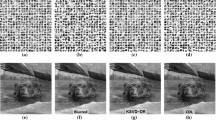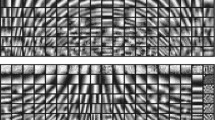Abstract
In this paper, we proposed a novel sparse representation-based blind image deblurring algorithm, which exploits the benefits of coupled sparse dictionary, and patch gradient orientation-based sparsifying sub-dictionary learning. We jointly trained coupled dictionaries for blurred and clear image patches to take advantages of the similarity of sparse representation in the blurred and clear image patch pair with respect to their corresponding dictionaries. The first step of the algorithm is to estimate blur kernel from the test image itself which is utilized in generating blur image training set from the clear image training set. Instead of learning a large coupled dictionary, we have proposed to cluster the patches having similar geometric structures and learn smaller sub-dictionaries for each group to improve the effectiveness of sparse modeling of the information in an image. While reconstructing the image, the sparse representation of a blurred image patch is applied to the blur-free dictionary to generate a blur-free image patch. For choosing a sub-dictionary which best describes a particular patch, minimum residue error criterion is formulated. An iterative error compensation mechanism is carried out to enhance the deblurring performance and to compensate for sparse approximation. The performance of proposed deblurring method is evaluated in terms of PSNR, SSIM, ISNR, and visual quality results. The simulation results demonstrate that the proposed method achieves very competitive deblurring performance as compared to other complementary blind deblurring methods.





Similar content being viewed by others
References
Vishwakarma DK, Singh K (2016) Human activity recognition based on spatial distribution of gradients at sub-levels of average energy silhouette images. IEEE Trans Cogn Dev Syst PP(99):1
Elad M, Aharon M (2006) Image denoising via sparse and redundant representations over learned dictionaries. IEEE Trans Image Process 15(12):3736–3745
Singh K, Vishwakarma DK, Walia GS, Kapoor R (2016) Contrast enhancement via texture region based histogram equalization. J Mod Opt 63(15):1444–1450
Yang J, Wright J, Huang T, Ma Y (2010) Image super-resolution via sparse representation. IEEE Trans Image Process 19(11):2861–2873
Ben-Ezra M, Nayar S (2004) Motion-based motion deblurring. IEEE Trans Pattern Anal Mach Intell 26(6):689–698
Donoho D (2006) Compressed sensing. IEEE Trans Inf Theory 52(4):1289–1306
Aharon M, Elad M, Bruckstein A (2006) K-SVD: an algorithm for designing overcomplete dictionaries for sparse representation. IEEE Trans Signal Process 54(11):4311–4322
Dong W, Zhang L, Shi G, Wu X (2011) Image deblurring and super-resolution by adaptive sparse domain selection and adaptive regularization. IEEE Trans Image Process 20(7):1838–1857
Singh K, Gupta A, Kapoor R (2015) Fingerprint image super-resolution via ridge orientation-based clustered coupled sparse dictionaries. J Electron Imaging 24(4):043015-1–043015-10
Singh K, Kapoor R, Nayar R (2015) Fingerprint denoising using ridge orientation based clustered dictionaries. Neurocomputing 167:418–423
Fergus R, Singh B, Hertzmann A, Roweis S, Freeman W (2006) Removing camera shake from a single photograph. In: SIGGRAPH
Shan Q, Jia J, Agarwala A (2008) High-quality motion deblurring from a single image. ACM Trans Graph 27(3):1–10
Zhang H, Zhang Y (2009) Sparse representation based iterative incremental image deblurring. In: IEEE international conference on image processing
Cai J, Ji H, Liu C, Shen Z (2009) Blind motion deblurring from a single image using sparse approximationty. In: IEEE conference on computer vision and pattern recognition
Hu Z, Huang J, Yang M (2010) Single image deblurring with adaptive dictionary learning. In: IEEE international conference on image processing
Zhang H, Yang J, Zhang Y, Huang T (2011) Sparse representation based blind image deblurring. In: IEEE international conference on multimedia and expo
Lou Y, Bertozzi A, Soatto S (2011) Direct sparse deblurring. J Math Imaging Vis 39(1):1–12
Liu Q, Liang D, Song Y, Luo J, Zhu Y, Li W (2013) Augmented Lagrangian-based sparse representation method with dictionary updating for image deblurring. SIAM J Imaging Sci 6(3):1689–1718
Tikhonov AN, Arsenin VY (1979) Solutions of ill-posed problems. SIAM Rev 21(2):266–267
Cho S, Lee S (2009) Fast motion deblurring. ACM Trans Graph 28(5):1–8
Feng X, Milanfar P (2002) Multiscale principal components analysis for image local orientation estimation. In: Asilomar conference on signals, systems and computers
Wang Z, Bovik A, Sheikh H, Simoncelli E (2004) Image quality assessment: from error visibility to structural similarity. IEEE Trans Image Process 13(4):600–612
Author information
Authors and Affiliations
Corresponding author
Rights and permissions
About this article
Cite this article
Singh, K., Vishwakarma, D.K. & Walia, G.S. Blind image deblurring via gradient orientation-based clustered coupled sparse dictionaries. Pattern Anal Applic 22, 549–558 (2019). https://doi.org/10.1007/s10044-017-0652-5
Received:
Accepted:
Published:
Issue Date:
DOI: https://doi.org/10.1007/s10044-017-0652-5




